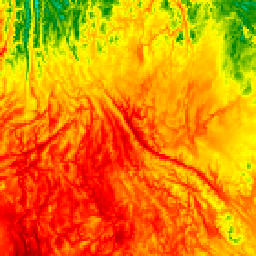
- Disponibilidade de conjuntos de dados
- 1983-01-01T00:00:00Z–2016-12-31T00:00:00Z
- Provedor de conjunto de dados
- UCSB/CHG
- Cadência
- 1 dia
- Tags
Descrição
O produto de dados de temperatura diária do Climate Hazards Center InfraRed Temperature with Stations (CHIRTS-daily; Verdin et al. 2020) é um conjunto de dados em grade quase global de alta resolução (0, 05° × 0, 05° de resolução, 60°S a 70°N) que fornece temperaturas diárias mínimas (Tmin) e máximas de 2 metros (Tmax) e quatro variáveis derivadas: pressão de vapor de saturação (SVP), déficit de pressão de vapor (VPD), umidade relativa (RH) e índice de calor (HI). Os produtos de temperatura CHIRTS foram criados para oferecer suporte à análise de extremos e variabilidade de temperatura, especialmente em regiões com baixa densidade de observações de estações.
O CHIRTS-daily é criado pela fusão de um conjunto de dados de temperatura máxima mensal de alta qualidade e resolução, o registro climático de temperatura máxima mensal do Centro de Riscos Climáticos InfraRed com Estações (CHIRTSmax; Funk et al. 2019), com temperaturas diárias da Reanálise v5 (ERA5) do Centro Europeu para Previsões Meteorológicas de Médio Alcance (ECMWF). O resultado é um conjunto de dados de temperatura diária de alta resolução que mantém informações espaço-temporais do CHIRTSmax mensal e a variabilidade de temperatura diária e diurna do ERA5. Os CHIRTSmax mensais são baseados em:
Uma climatologia de Tmax construída usando regressões geoestatísticas e médias de longo prazo de observações de estações da FAO, temperaturas do ERA5 e vários outros preditores geográficos.
Estimativas da variabilidade de Tmax usando aproximadamente 15.000 observações in situ e observações de satélite de alta resolução (0,05° × 0,05°). Esses dados são de relatórios de estações da Berkeley Earth e do Sistema Global de Telecomunicações (GTS, na sigla em inglês) e de temperaturas de brilho infravermelho térmico de satélites geoestacionários GridSat com triagem de nuvens.
Os valores diários de Tmax são produzidos usando anomalias de Tmax do ERA5 reduzidas e CHIRTSmax de alta resolução. Os valores diários de Tmin são criados removendo o intervalo de temperatura diurna reduzido do ERA5 (Tmax - Tmin). Os valores diários de SVP, VPD, RH e HI são calculados usando Tmin e Tmax diários do CHIRTS, além de entradas horárias do ERA5 para outras variáveis meteorológicas (consulte Williams et al., 2024, para mais detalhes). CHIRTS-diário, versão 1, abrange o período de 1983 a 2016.
Bandas
Tamanho do pixel
5566 metros
Bandas
| Nome | Unidades | Mín. | Máx. | Tamanho do pixel | Descrição |
|---|---|---|---|---|---|
minimum_temperature |
°C | metros | A temperatura mais baixa do ar registrada a 2 metros acima da superfície do solo em um período de 24 horas. |
||
maximum_temperature |
°C | 10* | 40* | metros | A maior temperatura do ar registrada a 2 metros acima da superfície do solo em um período de 24 horas. |
saturation_vapor_pressure |
kPa | metros | A quantidade máxima de vapor de água que o ar pode conter em uma determinada temperatura e pressão a 2 metros acima do solo. |
||
vapor_pressure_deficit |
kPa | metros | A diferença entre a pressão de vapor de saturação e a pressão de vapor real a 2 metros acima do solo. |
||
relative_humidity |
% | metros | A proporção entre a quantidade real de vapor de água no ar e a quantidade máxima que ele pode conter nessa temperatura e pressão (pressão de vapor de saturação) a 2 metros acima do solo. |
||
heat_index |
°F | metros | Uma medida de como está a sensação térmica quando a temperatura e a umidade são combinadas. |
Termos de Uso
Termos de Uso
Esses conjuntos de dados estão em domínio público. Na medida do possível de acordo com a lei, Chris Funk renunciou a todos os direitos autorais e direitos relacionados ou vizinhos ao produto de dados de temperatura diária de temperatura infravermelha de riscos climáticos com estações (CHIRTS-diário).
Citações
Verdin, A., C. Funk, P. Peterson, M. Landsfeld, C. Tuholske e Grace, K., 2020: desenvolvimento e validação do conjunto de dados de temperatura diária de alta resolução quase global do CHIRTS. Scientific Data, 7(1), 303. doi: 10.1038/s41597-020-00643-7
Funk, C., P. Peterson, S. Peterson, S. Shukla, F. Davenport, J. Michaelsen, K.R. Knapp, M. Landsfeld, G. Husak, L. Harrison, J. Rowland, M. Budde, A. Meiburg, T. Dinku, D. Pedreros, and N. Mata, 2019: um registro de dados climáticos de alta resolução de Tmax de 1983 a 2016 com base em temperaturas infravermelhas e estações do Climate Hazard Center. J. Climate, 32, 5639-5658. doi:10.1175/JCLI-D-18-0698.1
Williams, E., C. Funk, P. Peterson, and C. Tuholske (2024). Observações e projeções de alta resolução sobre mudanças climáticas para a avaliação de extremos relacionados ao calor. Scientific Data, 11(1), 261. doi: 10.1038/s41597-024-03074-w
DOIs
Explorar com o Earth Engine
Editor de código (JavaScript)
var dataset = ee.ImageCollection('UCSB-CHG/CHIRTS/DAILY') .filter(ee.Filter.date('2016-05-01', '2016-05-03')); var maximumTemperature = dataset.select('maximum_temperature'); var visParams = { min: 10, max: 30, palette: ['darkblue', 'blue', 'cyan', 'green', 'yellow', 'orange', 'red','darkred'], }; Map.setCenter(-104.28, 46.07, 3); Map.addLayer(maximumTemperature, visParams, 'Maximum temperature');
